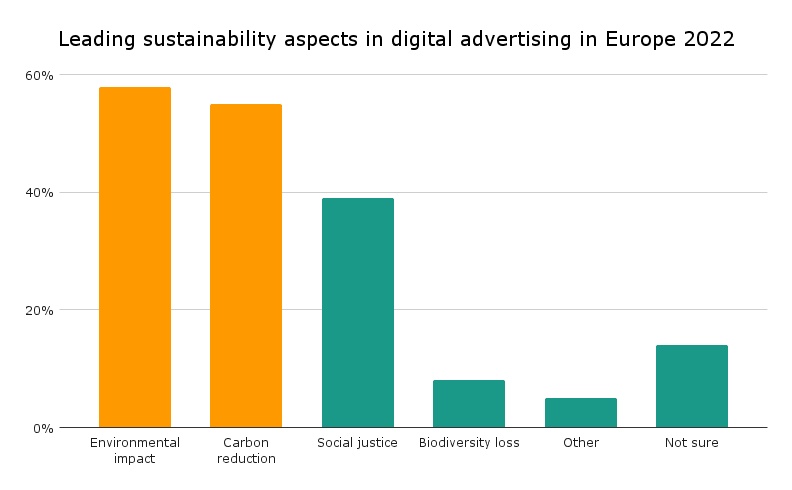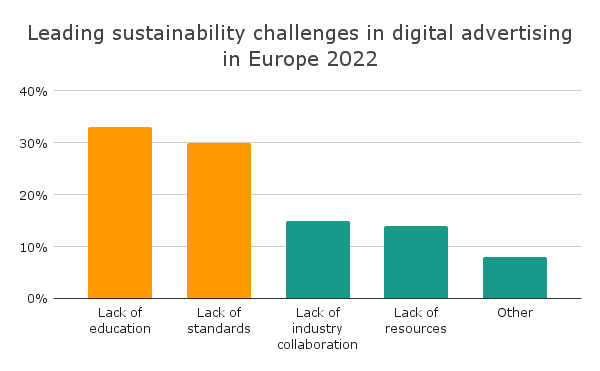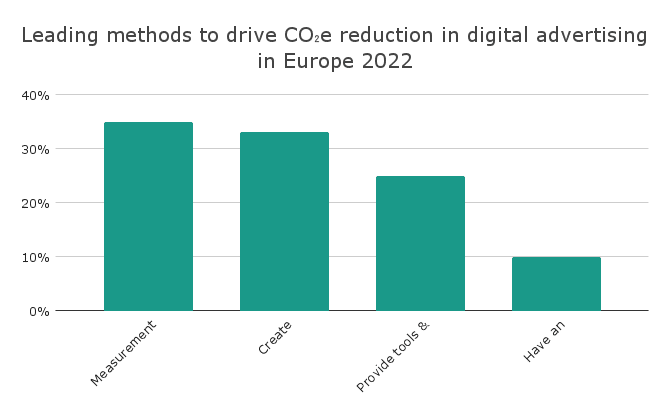Sustainability in digital advertising refers to the adoption of environmentally and socially responsible practices in the creation, delivery, and consumption of digital advertising content.
The world has been increasing its reliance on digital technologies. As a result, the environmental impact of digital advertising has become a significant concern. Many companies are now looking for ways to reduce their carbon footprint and promote sustainability. Digital advertising, which may come as a surprise to many, has the potential to contribute to this effort. In addition, sustainability in digital advertising is not only a matter of environmental responsibility but also an opportunity for companies to enhance their reputation, build brand trust, and contribute to a more sustainable and socially responsible future.
Why is sustainability in advertising and marketing important

Source: IAB Europe. (February 2, 2023). Leading sustainability aspects in digital advertising according to advertising executives in Europe as of December 2022 [Graph]. In Statista.
“Digital advertising accounts for up to 2% of global carbon emissions, which is equivalent to the entire aviation industry”
The increase of sustainability in digital advertising is a reflection of the growing awareness of the environmental and social impact of digital technologies. Consumers have become more environmentally conscious and demand greater transparency and accountability from companies. As a result, many digital advertisers are rethinking their practices and adopting more sustainable strategies.
Sustainability in digital advertising is important for several reasons. Firstly, digital advertising is responsible for a significant amount of energy consumption and greenhouse gas emissions. According to some estimates, digital advertising accounts for up to 2% of global carbon emissions, which is equivalent to the entire aviation industry. This makes it crucial to adopt sustainable practices in digital advertising to reduce carbon emissions and minimize the environmental impact of this industry.
Secondly, sustainability in digital advertising is important for promoting social responsibility. Digital advertising has the power to shape public opinion and influence consumer behavior. As such, it has a responsibility to promote ethical and socially responsible practices. This includes adopting practices that promote diversity, inclusion, ethical production practices, community engagement, and social responsibility. By promoting these values, digital advertising can play a role in creating a more equitable and sustainable society.
What are the challenges in implementing sustainability

Source: IAB Europe. (February 2, 2023). Leading sustainability challenges in digital advertising according to advertising executives in Europe as of December 2022 [Graph]. In Statista.
1. Lack of awareness: Many companies may not fully understand the impact of digital advertising on the environment or the benefits of sustainability. This lack of awareness can make it difficult to gain buy-in from stakeholders and secure the necessary investment.
2. Complexity: Digital advertising is a complex ecosystem, with many different players, platforms, and technologies involved. Implementing sustainable practices in this environment requires collaboration and coordination across different stakeholders, which can be challenging.
3. Lack of standards: The absence of widely accepted standards for sustainable digital advertising can make it difficult for companies to know how to measure and report on their sustainability efforts. This lack of clarity can make it challenging to set goals, track progress, and communicate achievements to stakeholders.
Setting the standard for sustainable digital advertising: the IAB definition
In an effort to address the lack of standards, the IAB Europe’s Sustainability Standards Committee has defined sustainable digital advertising as using digital marketing and advertising techniques that mitigate negative impacts on the environment and society while being economically viable. The definition covers the three pillars of sustainability: environmental, social, and economic.
1. The environmental aspect includes reducing carbon emissions and unnecessary energy consumption associated with the delivery of digital ads.
2. Social sustainability encompasses impact on people and communities such as employment, diversity and inclusion, data privacy and ethics, and fraud and transparency.
3. Economic sustainability concerns generating profits, supporting employees and communities financially, and efficiency of operations.
By aligning their sustainability practices with the CSRD and considering all three pillars of sustainability, digital advertising companies can address the need for immediate action to tackle the climate crisis while ensuring the long-term health and prosperity of the industry and the communities it serves.
How can digital advertising reduce carbon emissions

Source: IAB Europe. (February 2, 2023). Leading methods to drive carbon dioxide equivalent (CO₂e) reduction in digital advertising according to advertising executives in Europe as of December 2022 [Graph]. In Statista.
Optimize ad delivery:
– Use algorithms that optimize ad delivery, reduce page load times, and minimize the number of ad requests sent to servers.
– Cut down on middlemen in the ad tech process to decrease processing power. For example, data companies that integrate directly with DSPs and DMPs use fewer intermediaries. An added benefit is more competitive pricing.
– Change the monetization system of web pages. The current system of monetizing a single web page is done through multiple transactions over many trading platforms. One potential efficiency for this process is “batch-based buying” to reduce the footprint for each ad loaded on the page.
Reduce ad waste:
– Implement more targeting. Targeting is a better use of marketing budgets, drastically reducing pointless impressions that needlessly generate carbon emissions. Processes for targeting audiences have a low carbon footprint. To calculate the impact of targeting, advertisers can use the “gCO2PM”, or carbon cost (gCO2eq) per 1000 impressions.
– Rethink advertising formats, especially unnecessary long-form videos. Video is the heaviest of advertising formats. Reducing the size of a video involves making it shorter or using a lower resolution. Shortening a video by 3 seconds reduces CO2eq emissions by 20%, while shooting the video in 720p instead of 1080p reduces CO2eq by 30%.
Incentivize use of renewables:
– Use hosting providers that are committed to sustainability can help reduce the environmental impact of digital advertising. Green hosting providers use renewable energy sources to power their data centers and have implemented energy-efficient technologies to reduce energy consumption.
– Introduce Green Media Products (GMPs). These are carbon-neutral media and can be easily measured per advertising campaign. By allocating spend to GMPs, carbon can be priced into decisions for reducing emissions.
– Develop carbon calculators for digital advertising agencies to be able to calculate and be aware of the carbon footprint of their campaigns.
How can digital advertising promote social sustainability
Digital advertising should also adopt practices that promote social responsibility and support social causes. Here are some ways digital advertising can promote social sustainability:
Promote diversity and inclusion:
Showcase a diverse range of individuals in their ads and make an effort to avoid stereotypes. This can also help promote positive representations of marginalized communities.
Support social causes:
Partner with nonprofits and other organizations to promote social causes and raise awareness of issues such as climate change, human rights, and social justice. Foster community engagement by encouraging consumers to participate in social initiatives and engage with social issues through their campaigns.
Ensure ethical practices:
Ensure that data collection and use are conducted in an ethical and responsible manner, respecting the privacy and rights of consumers.
The industry has taken the first few steps towards achieving sustainability in digital advertising. The transition is, of course, easier said than done but whatever small change we can do today we definitely should not delay for tomorrow. As more people and businesses get more involved and more effort and work is put in, sustainability in this industry will keep on improving and evolving.
What are the current efforts in promoting sustainable practices in advertising
Listed below are a few examples of the many companies that are taking steps to reduce the environmental impact of their digital advertising operations. By implementing sustainable practices, these companies are not only helping to address the urgent issue of climate change, but they are also improving their brand reputation and attracting socially conscious consumers.
1. Google: In 2020, Google announced that it would be moving to using 100% renewable energy for all of its data centers and offices by 2030. This will help to reduce the carbon footprint of the company’s digital advertising operations.
2. Unilever: Unilever has set a goal to make all of its brands’ advertising campaigns sustainable by 2025. This includes reducing the carbon footprint of campaigns and using sustainable materials in production.
3. The Trade Desk: The Trade Desk, a programmatic advertising platform, has launched a program called “The Trade Desk Greenhouse” which helps advertisers measure and offset the carbon emissions associated with their digital advertising campaigns.
4. GroupM: GroupM, a media investment company, has created a “Digital Responsibility and Sustainability” practice to help its clients reduce the environmental impact of their digital advertising campaigns. This includes providing guidance on sustainable media buying and working with vendors to reduce the carbon footprint of their services.
5. Procter & Gamble: Procter & Gamble has set a goal to use 100% renewable energy for all of its manufacturing sites by 2030. This will help to reduce the carbon footprint of the company’s advertising campaigns, which often involve the production and distribution of physical products.
Want to move towards a more sustainable digital advertising? Follow us on linked in and learn more about sustainability in digital advertising
https://www.linkedin.com/company/indaru/
Featured Image by Freepik




